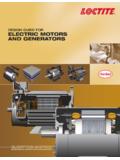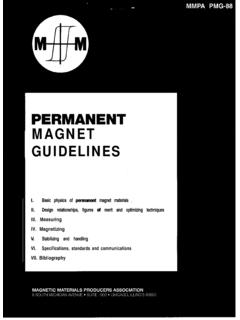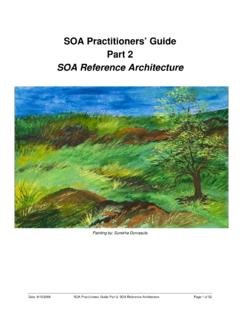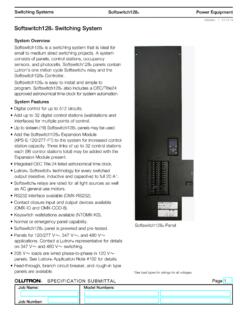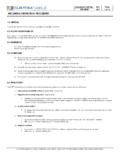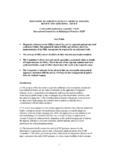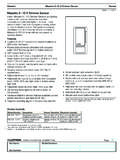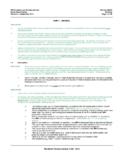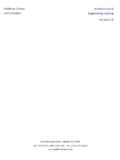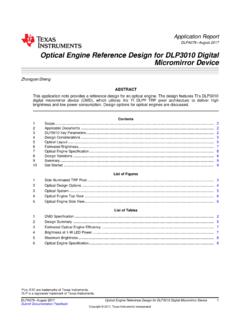Transcription of STANDARD SPECIFICATIONS FOR PERMANENT ... - …
1 MMPA STANDARD No. 0100-00 STANDARD SPECIFICATIONSFORPERMANENTMAGNETMATERIAL SMAGNETIC MATERIALS PRODUCERS ASSOCIATION8 SOUTH MICHIGAN ANENUE SUITE 1000 CHICAGO, ILLINOIS 60603 FOREWORDThis publication represents STANDARD practices in the United States relating to permanentmagnet materials. This STANDARD is a revision of MMPA STANDARD OlOO-StandardSpecifications for PERMANENT magnet Materials which was originally published in 1964,plus important information from the latest documents prepared by the InternationalElectrotechnical Commission (IEC) Technical Committee is the oldest continuously functioning standards organization in the world. In 1906, theIEC was given the responsibility of securing the cooperation of technical societies toconsider the question of international electrical standardization.
2 The membership of IECconsists of 41 national committees, one for each country. These committees represent theelectrical interests of producers, users, government, educators and professional societies ofeach country. The MMPA is represented on the United States National Committee is hoped that the data in this publication will serve as a guide to governmental andindustrial purchasers so that they may be assured of uniform quality manufactured tocommercial standards . These STANDARD SPECIFICATIONS were developed under the auspices ofthe Magnetic Materials Producers Association and were voluntarily established by mutualconsent of those concerned. These SPECIFICATIONS are advisory only and their use oradaptation is entirely voluntary. The users of the specification are wholly responsible forprotecting themselves against all liabilities for patent IGeneral IIAlnico IIIC eramic IVRare Earth VIron-Chrome-Cobalt APermanent magnet Materials Not Covered in Product Sections (See Section I Scope).
3 23 Appendix BGlossary of CMagnetic Quantities (Symbols, Units and Conversion Factors)..27 STANDARD SPECIFICATIONS FOR PERMANENT magnet MATERIALSSECTION SCOPE & Scope: This STANDARD defines magnetic, thermal,physical and mechanical characteristics and properties ofcommercially available PERMANENT magnet materials aslisted in Table are a large number of PERMANENT magnet materi-als in use which are not described in this materials generally fall into one of the followingcategories: (a) Older materials that have been largely replaced bynew materials. (b) Materials made by only one company with a spe-cialized and limited use. (c) Materials evolving. from development status toproduction which at this time are not mature from acommercial reference purposes, the principal magnetic proper-ties of the materials in the above categories are listed inAppendix Objective: The objective of this STANDARD is to es-tablish criteria by which users of PERMANENT magnetmaterials may be assured of magnets manufactured topresent commercial DEFINITIONS & Definitions: The following definitions characterizematerials covered in this PERMANENT magnet (Magnetically Hard)Material: A PERMANENT magnet material, also designatedas a magnetically hard material, has a coercive forcegener-ally greater than 120 Individual magnet .
4 The term individual magnetdenotes a magnet purchased in a size and shape to beready for direct incorporation into a magnetic Bulk magnet Material: The term bulk magnet ma-terial designates bar, rod, slab, strip, sheet, etc., fromwhich the purchaser cuts, stamps or forms Polarity of a Magnetized magnet : The NorthPole of a magnet is that pole which is attracted to thegeographic North Pole. Therefore, the North Pole of amagnet will repel the north seeking pole of a Demagnetized magnet : For the purposes of thisstandard, a magnet shall be considered demagnetized if,when any of its poles is dipped in soft iron powder (of-5, + 10 mesh), not more than 3 particles of powderadhere to it anywhere upon Terms: A glossary of terms commonly used withpermanent magnetic materials is given in Appendix CONDITIONU nless otherwise specified, bulk magnet materials shallbe furnished in the non heat-treated condition, as rolled,as forged, or as-cast condition as applicable.
5 Individualmagnets shall be furnished in a fully heat-treated anddemagnetized CLASSIFICATION & Classification: The classification of permanentmagnet materials covered by this STANDARD is given inTable 1. Section numbers for the material classes cov-ered in this STANDARD as well as reference to the Interna-tional Electrochemical Commission (IEC) material codenumbers are also given in the 1 MATERIAL CLASSIFICATIONM aterialMMPAS ectionIEC CodeAlnicoCeramicRare-EarthIron-Chromium -CobaltIIIIIIVVR1S1R4, Designation: PERMANENT magnet materials in thisspecification will be divided into separate sections by theMMPA Class. Each STANDARD section will address therelevant properties, characteristics and SPECIFICATIONS ofeach class of materials and the established sub-grades.
6 Ingeneral, reference will be made to historically recog-nized subgrade descriptions (such as Alnico 1,2, etc., orCeramic 5, 8, etc.) and to a system, referred to as theBrief Designation, that classifies each subgrade by typi-cal normal energy product and typical intrinsic coerciveforce. In this system, for example, a material havingmaximum normal energy product of megagauss-oersteds (MGO) and an intrinsic coercive force of 2000oersteds ( kOe) would be assigned a Brief Designa tion of When similar grades exist the nearestIEC Grade Code Number will also be listed for MAGNETIC PROPERTIES, THERMALPROPERTIES & OTHER CHARACTERISTICSThe magnetic, thermal, surface and internal structure,and other physical characteristics are set forth in tables ineach section for the different classes of magnetic3materials.
7 The figures in these tables are intended to bedescriptions of each of the materials. The properties ofthe materials produced by individual manufacturers maydiffer somewhat from those shown. For informationconcerning properties of actual grades produced, refer toindividual manufacturer s literature. The propertiesshown in the tables with each class shall not be used asinspection criteria of either individual magnets or bulkmagnet Principal Magnetic Properties: Permanentmagnet materials are identified by the followingprincipal magnetic properties:Maximum value of energy product (BH)max MGOR esidual induction Br gaussCoercive force Hc oerstedsThe measurement of the principal magnetic propertiesare made in a in closed magnetic circuit permeameter bycommonly accepted procedures such as given in IECS tandard Publication 404-5 Methods of Measurement ofMagnetic Properties of Magnetically Hard (PermanentMagnet) Materials or the MMPA PERMANENT MagnetGuidelines (current edition).
8 They are accurate only formagnets having a straight magnet axis and producedwith a constant cross section along the axis ofmagnetization. The minimum magnet volume of asample used to measure these magnet properties shall beone cubic centimeter and the smallest dimension shall beat least 5mm. The performance of a PERMANENT magnetcircuit is de-pendent on the dimensions of allcomponents and the properties of the other componentsof the circuit, as well as the properties of the permanentmagnet. It is recommended not to use unit properties of amaterial as the specification . These are generallyrecommended to be only used on prints or drawings toshow a subgrade within a material group. Section ofthe specification describes the proper means ofspecifying the acceptable properties of a permanentmagnet component Thermal Properties: Predicting magnetperformance as a function of the magnet s temperaturerequires knowledge of the following thermal properties.
9 Reversible temperature coefficient of the residualinduction TC (Br) %/ CReversible temperature coefficientof the intrinsic coercive force TC (Hci) %/ CCurie temperature Tc CMaximum service temperature T max CThe values listed for each class of materials for thermalproperties are typical values intended as design guide-lines only and are not to be used as a basis for accept-ance or rejection. Values for irreversible temperaturecharacteristics are not listed because they depend on themagnet material, geometry and circuit in which themagnet is Surface and Internal Structure Characteristics: PERMANENT magnet materials have been developedprimarily for their magnetic properties.
10 The magneticproperties of some materials are produced usingmanufacturing techniques which are not consistent withpro-ducking perfect physical specimens. Minor physicalimperfections rarely impair the magnetic capabilities of amagnet or compromise its stability or ability to resistdemagnetization. Imperfections commonly found inpermanent magnet materials shall be judged acceptable ifthe following conditions are met:(I) The magnet meets the magnetic performance criteriaagreed upon between the magnet manufacturer andcustomer.(2) The imperfections do not create loose particles thatwould interfere with proper assembly or functioning inthe end use device. Unless otherwise agreed, visualimperfection guidelines listed in the individual materialsections Other Physical Properties: Typical values forother physical properties important to a magnet user arelisted in the tables in the sections for each class ofpermanent magnet material and are intended to be de-scrimptions of the material, not criteria for acceptance MECHANICAL CHARACTERISTICSMost PERMANENT magnet materials lack ductility and areinherently brittle.
